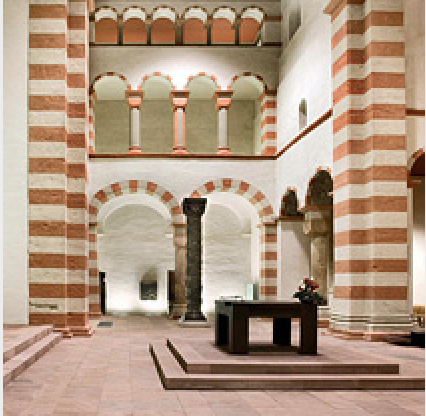1000 Years St. Michael's in Hildesheim
Church - Monastery - Founders
International conference organized by the Hornemann Institute
16th - 18th of September 2010 | St. Michael's in Hildesheim
The Conference
The aim of the three-day international and interdisciplinary conference was to gather scientists from home and abroad in the church to gain new insights concerning the cultural history of the former Benedictine Monastery of St. Michael throughout history. Thus taking up a long-discussed, desired research.
The time seemed ideal as in recent years important publications have appeared in a variety of disciplines, the results of which could be discussed from different vantage points and further developed in this symposium. Moreover, since 2005, the church has undergone extensive renewal, including archaeological excavations.
The Following Topics Were Discussed:
- New discoveries on St. Michael’s
- Bishop Bernward and the building of St. Michael’s
- Bishop Bernward and his donations
- The canonization of Bernward and the monastery in the 12th and 13th centuries
- Church and monastery in the late Middle Ages
- St. Michael’s since the Reformation
The Book
24 essays are published now with financial support from the Fritz Thyssen Stiftung and the Friedrich-Weinhagen Stiftung as a representative book. The book is edited by Gerhard Lutz and Angela Weyer, who also prepared and organized the conference in 2010.
This book combines richly illustrated articles from different fields including art history, (church) history, archaeology, architecture and conservation offering insights into the history of the 1000 years old monastery.
A focus of the conference proceedings is on Bishop Bernward of Hildesheim, the tutor of Emperor Otto III., and his unparalleled donations at that time, among them St. Michael’s monastery. Other essays are devoted to the later development of church and monastery, from the reform of the monastic community in the 15th century, the Reformation and the Baroque monastic culture to the destruction of 1945 and the subsequent reconstruction.
"I was fascinated by the diversity of approaches in the essays which not only reflect the different disciplines of their authors: In addition to more traditional methods to analyze sources, archival materials, building inscriptions, plans and observations in the building itself some authors discuss theological texts, technical findings on the objects, European comparative examples, or trace today’s location of the of the treasures of the monastery. “Each essay is a unique experience”, according to Angela Weyer, co-editor of the book and director of the Hornemann Institute of the HAWK.
Useful Links
Conference proceedings
1000 Jahre St. Michael in Hildesheim. Kirche – Kloster – Stifter
Gerhard Lutz und Angela Weyer (Ed.), Petersberg 2012
The book is sold out, it is available here for download.


